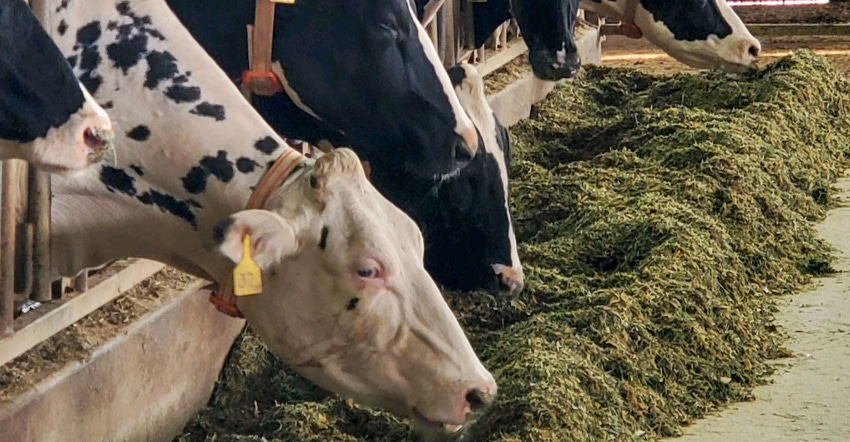
In early 2020, Jim and Lanette Harsdorf and their son Justin, who farms with them, were looking for a way to cut expenses and boost productivity on their family dairy farm, Trim-Bel Valley Dairy, near Spring Valley, Wis. In May, the Harsdorfs chose to subscribe to an intelligent dairy cow assistant from Connecterra called Ida. Ida stands for intelligent dairy assistant.
With the Ida system, each cow wears a sensor that is attached to a neck strap. The system monitors the cow’s activity to determine when she is in heat and ready to breed. The system also keeps track of how much time the cow spends chewing her cud, lying down, walking, standing, being idle or eating; it monitors the cow’s daily feed intake. Ida combines behavioral data from the cows, farmer feedback and farm management systems; third-party data such as weather; feed software; and genomics. Ida then uses artificial intelligence to create actionable insights instead of simply showing data.
By using Ida as a phone app or by logging into the Ida program on the farm computer, employees can see alerts about both health issues and breeding needs. Brian Lee, Trim-Bel Valley Dairy manager, and Kevin Lee, the feeder, have access to this information.
Mark Mitchell has been herdsman at Trim-Bel Valley Dairy for the past six years. He found Connecterra’s booth at World Dairy Expo last year and made the initial contact. Today, Mitchell is very pleased with the system and how it has benefited the dairy operation.
“I get a text every day that tells me which cows need to be bred,” he says. “Our breeder gets a list that comes to his phone through an app, so he knows how many cows he will be breeding at our farm before he even leaves the house that morning.”
More cows pregnant
According to Mitchell, breeding at Trim-Bel Valley Dairy has been streamlined by Ida’s technology and by switching from weekly pregnancy checks by the veterinarian to weekly blood testing to determine if cows are pregnant. Mitchell says Ida can detect silent heats they miss, which allows them to do a much better job breeding. They are now using Ida’s information to breed rather than relying on synchronized breeding.
“Before Ida, we were dependent on synchronized breeding, which required a lot of my time in the pens, making lists of cows to check, walking pens and moving animals,” he says. “By breeding when Ida reports that a cow needs to be bred, I feel that the cows are more relaxed, and it is less stress on me physically and mentally.”
Mitchell says that at age 61, it is important for his job to be more efficient and less demanding physically.
“Now I feel like I can work here for a few more years,” he says. “I don’t feel so exhausted. I can use my hours here more efficiently, and I also know that other people can monitor the cows when I am not on-site. I can use the app on my phone to tell others about a health or breeding need. I have more work-life balance.”
Identifying health needs
Mitchell says with the Ida system, he gets a daily alert indicating a cow is not eating or is eating less than the day before.
“It really catches potential health issues early so we can care for the cows right away,” he explains. “It’s less stressful to know that. Now I don’t have to rely on the milk weights to tell me. I know these cows. I can check and see if and why her intake of feed is off. Ida will help diagnose what is wrong with the cow from the farmer feedback. If there is something wrong — say, milk fever, metritis, pneumonia, ketosis — I can check on them, and then make the decision how to treat them myself or call our veterinarian.”
Justin Harsdorf says with Ida, they are catching sick cows a day or two earlier, before they come down with a displaced abomasum or even show signs they are sick.
“When a health issue comes up on a cow, it’s important to respond and find out if she is eating less because of fever or injury, for example,” Justin says.
“The cows are healthier,” he explains. “This app is another tool that allows us to monitor each cow individually and each group individually. That lets us decide on a treatment and then fix the problem.”
Mitchell likes being able to ask Ida farm-level questions on the Ask Ida feature, such as, “If I make a feed change in Group 2, what will be the impact of that change on feed intakes?” Or “What if I change bedding? How will that impact the cows’ lying time?”
“Ida answers that question on the timeline I set,” he explains.
 SMART HELP: “Ida will never grow old. Ida will just keep getting smarter,” says Mark Mitchell, Trim-Bel Valley Dairy herdsman.
SMART HELP: “Ida will never grow old. Ida will just keep getting smarter,” says Mark Mitchell, Trim-Bel Valley Dairy herdsman.

Mitchell says if the cows get a change of feed, he may get an alert that says they are eating less. On hot days, he got several of those alerts.
Trim-Bel Valley Dairy’s nutritionist has Ida on his phone and iPad. “He keeps an eye on the feed side and watches that,” Mitchell says. “He also can see if cows are off on intake. Because of Ida, we ended up making a change in our dry-cow ration because as a group, we were seeing health issues caused by diet.”
Mitchell explains that the farm uses DairyComp 305 herd management software. Ida integrates the DairyComp 305 information into the insights generated.
“If I bring a cow up, it will tell me she’s 200 days in milk and she’s pregnant,” he explains, adding, “Ida comes in multiple languages, so if you have any multilingual employees, they can use it, too.”
Mitchell says he is very happy with the Ida system. “Ida will never grow old. Ida will just keep getting smarter,” he says. “The service is just top-notch. If I have any questions at all, they have an answer for me, or they’re calling me back and asking questions.”
Return on investment
Jim Harsdorf says he is very satisfied with the Ida system and believes the Ida subscription system is paying for itself.
“When we expanded from 200 to 600 cows, we hired Mark as our herdsman. This program has reduced Mark’s efforts in our breeding program and allows him to be more proactive in our cow care,” Jim says. “It is taking the guesswork out of breeding, and we are saving costs on breeding and veterinary expenses. It’s a huge help having Ida say, ‘Go check this cow. It’s almost like having a 24/7 employee.”
Jim says Ida also has impacted the health of their animals, which in turn will impact the bottom line of productivity.
“Sometimes you don’t know what you are losing on a dairy when it comes to the animals’ health,” he says. “Healthy animals milk more, settle quicker and create a better working environment. We look forward to seeing the impact of Ida when we have been using the system for a whole year.
“At this time, Ida doesn’t provide milk weights. We test with DHI to know production and components. We know that when we are culling for milk production rather than breeding issues, we will also increase our herd average.”
Jim says Ida is helping them individualize cow care, which is important to all dairy farmers. “We are concerned about the welfare of our animals, and we feel that on our farm, this system helps us do the best job we can,” he concludes.
About the Author(s)
You May Also Like






